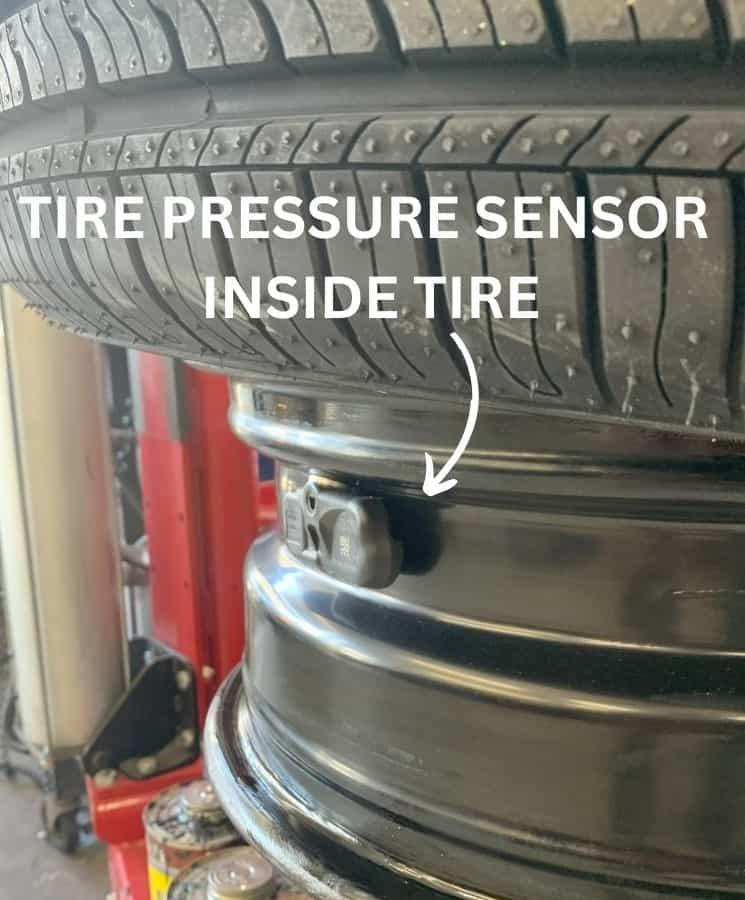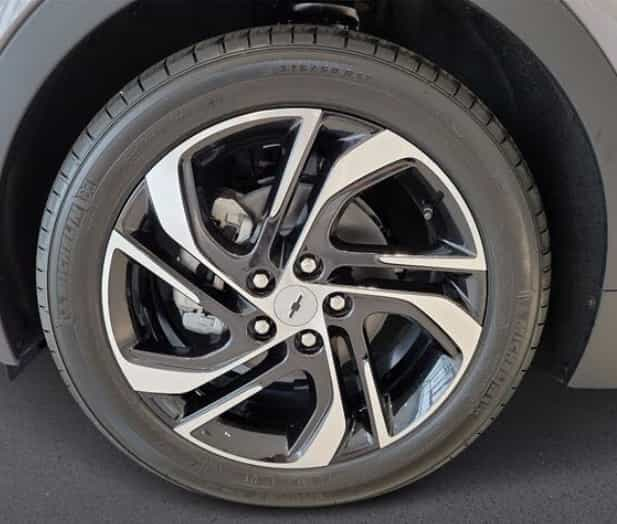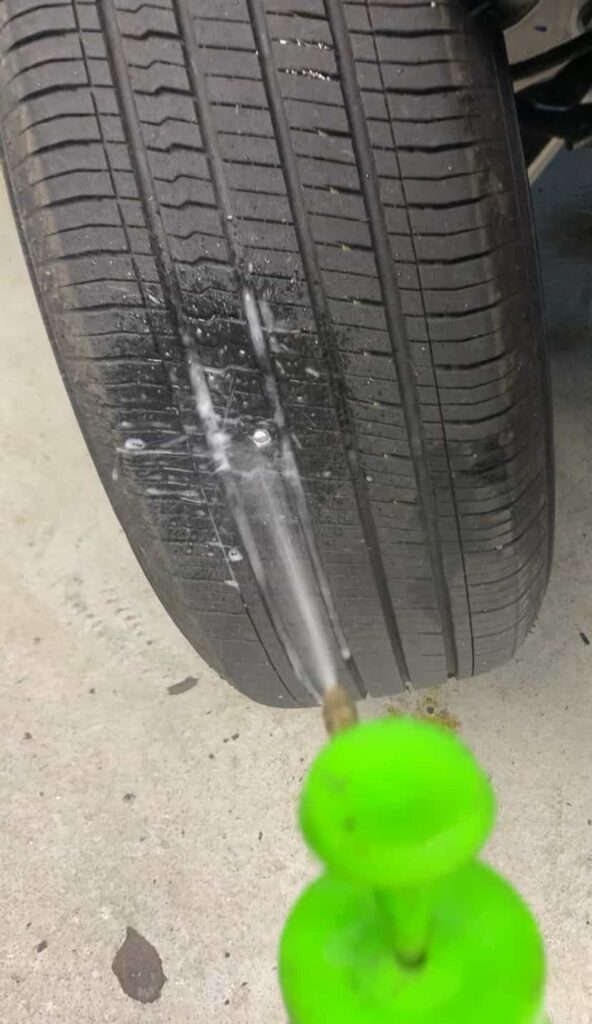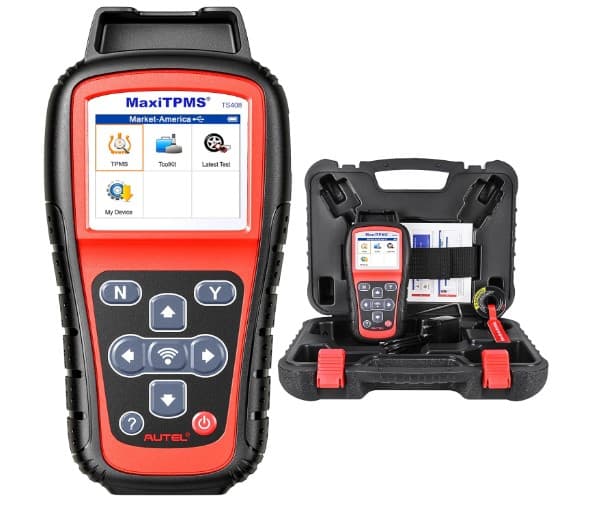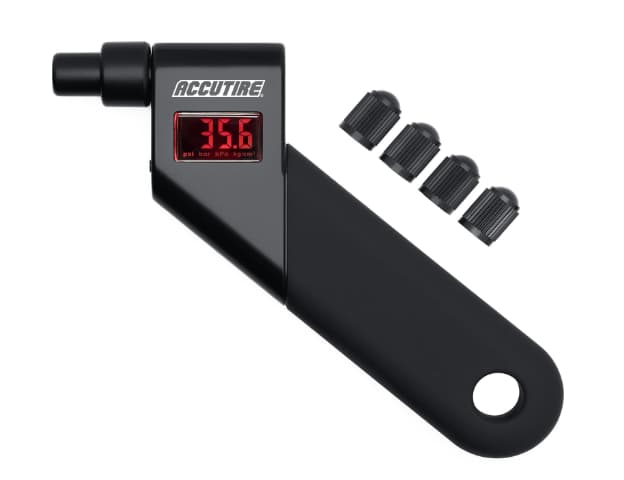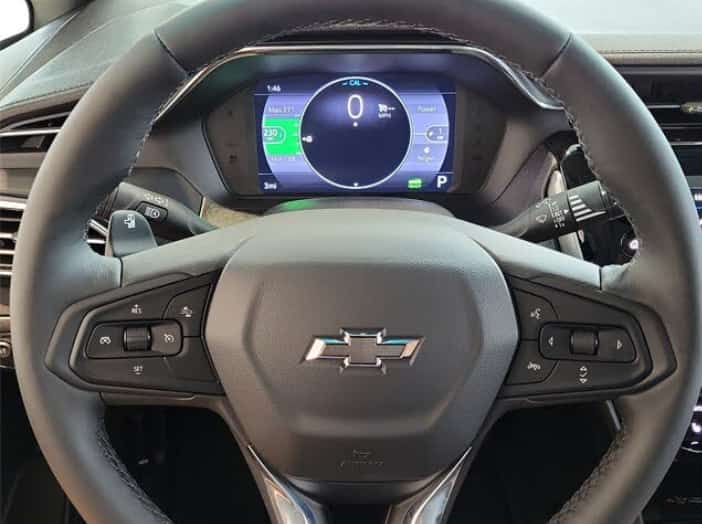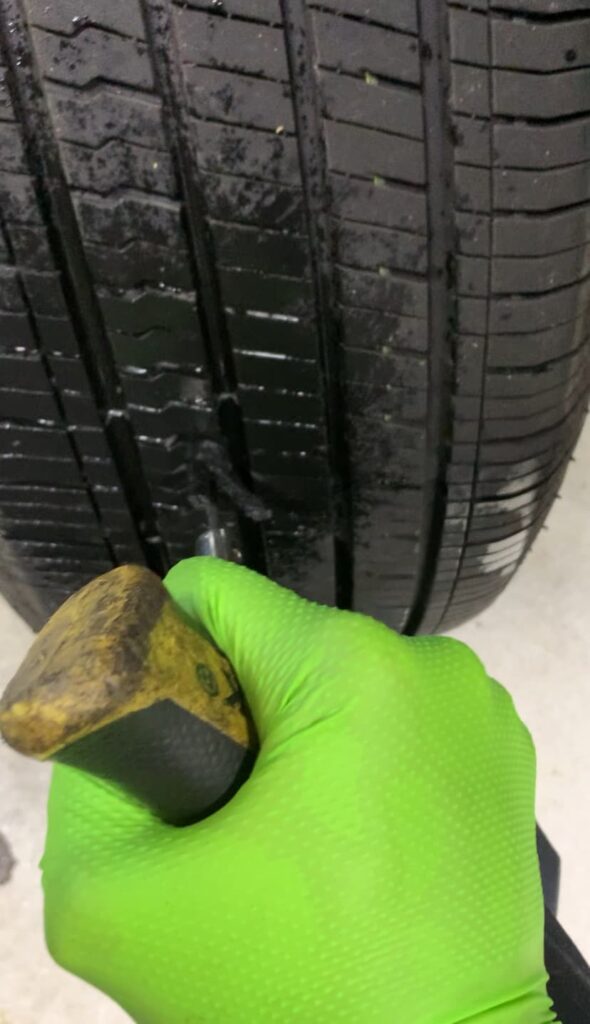What is the Chevy Bolt EV TPMS?
Your Chevrolet Bolt EV’s TPMS (tire pressure monitoring system) is a crucial but often overlooked component. Comprising the Bolt’s ECM, the TPMS receiving unit, and four pressure sensors, this system collaborates to display current tire pressure on the Chevy Bolt’s dashboard and warn you of any pressure drops.
How to Reset the Chevy Bolt EV Tire Pressure System
🔎 The Chevrolet Bolt EV lacks a TPMS reset button.
Ensure the tires reach ambient temperature.
Adjust the inflation of all Chevy Bolt tires based on the recommendations inside the driver’s door.
Drive the Chevy Bolt for several minutes at speeds exceeding 25 Mph.
How to Relearn the Chevy Bolt Tire Pressure Sensors (without a tool)
After tire-related services like balancing, wheel alignment, tire rotations, or tire pressure sensor maintenance/replacement on the Chevy Bolt EV, the tire pressure sensor relearning process should be executed. This ensures the car’s ECM accurately knows each tire’s location.
Inflate each tire to around 40 Psi.
With the engine off, switch on the Chevy Bolt’s ignition.
From the info display screen, navigate to “Menu.”
Choose “Vehicle Information.”
Go to the “Tire Pressure Menu.”
Long-press the SET/CLR button. The prompt “Are you sure that you want to relearn?” will appear.
Confirm with “Yes.”
If executed correctly, the car horn will sound twice.
The Bolt’s info screen will display “TIRE LEARNING ACTIVE.”
Exit the car, approach the front driver’s tire and release air until a beep sounds.
Repeat for front right tire, rear right tire, and rear left tires in that order.
Successful completion removes the “tire learning active” message from the display screen.
Turn off the ignition and revert tire pressures back to the Chevy Bolts recommended air pressure levels.
NOTE: Be sure to relearn the tire pressure sensors in the instructed order. (LF, RF, RR, RL)
How Does the Chevy Bolt TPMS Work?
Tire Pressure Sensor Placement and Function
Inside each wheel of a Chevy Bolt, you’ll find a discreetly placed tire pressure sensor right at the end of the valve stem. While they’re hidden from plain sight, these sensors are small circuit boards that are diligent in monitoring the ongoing air pressure and temperature of their respective tires.
Signal Transmission
Every individual tire sensor is equipped with its own transmitter. This transmitter’s job? To relay tire-specific data directly to the Bolt’s dedicated TPMS receiver module, all accomplished through radio wave transmissions.
Tire Data Processing
First stop for the data from these sensors is the TPMS receiver module. After collation, it’s promptly sent to the Bolt’s central computer system, commonly referred to as the ECM. Here, it undergoes analysis, contrasting real-time tire pressure and temperature readings against preset benchmarks set by Chevy.
Air Pressure Drops
Should the ECM detect a tire’s pressure dipping beneath the Bolt’s set safe threshold, it promptly triggers a “Low Tire Alert” on the vehicle’s info display screen. The alert is a warning message and a yellow exclamation mark symbol on the information display.
Self-Diagnostic Capabilities
The Chevy Bolt’s TPMS isn’t just about monitoring tires; it’s also self-aware. If there’s ever an internal malfunction, the driver is alerted via a flashing low tire pressure indicator.
2023 Chevy Bolt Tire Pressures
TIRE SIZE | FRONT PSI | REAR PSI |
215/50R17 | 38 | 38 |
What Can Trigger the Chevy Bolt EV Low Tire Pressure Light?
Incorrect tire pressure (under-inflated or over-inflated)
Air seepage from tires
TPMS sensors not present
TPMS sensor batteries losing charge or not working
Issues with the TPMS receiver or Chevy Bolt EV engine control module
Electromagnetic interferences from nearby electronics or other vehicles
Variations due to temperature or altitude
Overburdening the car’s weight limit
Application of chains on tires
Extreme window tint levels
Alterations in the temperature of the road surface
Issues like tire holes, tire dry-rot, or tire bubbles
Discrepant tire sizes
Wheels not properly aligned
TPMS sensor damaged upon tire fitting
Skipping TPMS reset or tire pressure sensor relearn after altering or servicing tires
Leaking tire valve stem
Chevy Bolt EV TPMS Sensor Batteries
Every tire pressure sensor within the wheels of the Chevy Bolt operates on a compact silver oxide battery. Typically, these batteries last between 5-10 years or cover a distance of 100,000-150,000 miles. They fuel the circuitry and the transmitter of each tire pressure sensor in the Chevy Bolt. It’s worth noting that once these TPMS sensor batteries drain or expire, they can’t be replaced or recharged, necessitating the replacement of the entire sensor.
Identifying and Diagnosing Low Tire Pressure Problems in the Chevy Bolt
Many Chevy Bolt EVowners find the tire pressure light to be persistent and irritating. Below are several suggestions for understanding why this light stays on and steps to turn it off if the usual TPMS reset and sensor relearn method fails.
TIP 1: WHAT A RECURRING TIRE LIGHT COULD MEAN FOR YOUR CHEVY BOLT
When the tire light is illuminated and you’ve filled all the tires to the suggested 38 Psi, the light turning off indicates that the tire pressure monitoring system in your Chevy Bolt is functioning correctly. However, if the light reappears post-inflation, it’s a sign that one of the tires might have an air leak. Use a manual tire gauge to recheck the pressures and determine which tire is losing air.
TIP 2: FIND YOUR TIRE LEAK WITH SOAPY WATER
After identifying the tire with decreased pressure, use this guide to pinpoint the exact leak location.
Required Tools: Tire pump, spray bottle, water, dish soap.
Procedure:
Inflate the tire to a pressure between 35 and 40 Psi using the tire pump.
Create a soapy solution with water and dish soap in the spray bottle. (A window cleaner like Windex can be a substitute.)
Generously spray the entire tire with the mixture.
Closely examine the tire for the formation of bubbles.
Follow the bubbles to their origin.
🔍Note: If the bubbles emerge from the tire’s tread, a patch or plug might fix it. Leaks on the bead seal require bead sealing, while issues stemming from the valve stem necessitate a replacement.
TIP 3: THE ROLE OF TPMS PROGRAMMING/RELEARN TOOLS IN DIAGNOSTICS
Should you suspect that the tire pressure light on your Chevy Bolt is due to a malfunctioning TPMS sensor, a TPMS programming/relearn tool can help you determine the issue. In my shop, I rely on Autel TPMS programming tools for all diagnostics related to tire pressure sensors. To use it, plug the tool into the Chevy Bolt’s OBD2 port. The tool will scan each sensor and provide a detailed report, including battery status, tire temperature, and signal strength of the tire pressure sensor.
🔍Note: If the results indicate a low battery in a sensor, give improbable temperature readings like -176 degrees, or signal transmission problems, it suggests the tire pressure sensor requires replacement.
TIP 4: AN ALTERNATIVE METHOD FOR A NON-RESPONSIVE CHEVY BOLT TPMS SENSOR
Should the Chevy Bolt’s TPMS relearn method not work for you, consider the following steps:
Deflate the troubled tire by at least 15 Psi.
Employ a tire pump to fill the tire up to 43 Psi, which is 5 Psi above the suggested level.
Drive the Chevy Bolt EV briefly with the tire filled beyond its recommended pressure.
Then, proceed with the Chevy Bolt TPMS relearn process above.
TIP 5: THE INFLUENCE OF TEMPERATURE ON THE CHEVY BOLT EV TIRE PRESSURE
Temperature variations play a pivotal role in determining the tire pressure of a Chevy Bolt EV. As a general guideline, a tire’s air pressure will shift approximately 1 Psi with every 10-12°F temperature adjustment. Here’s a typical example: Suppose you’ve parked your Chevy Bolt overnight at 79°F. By morning, if the temperature has plummeted to 41°F, it’s likely the low tire pressure alert will activate. This alert is a consequence of the tires losing about 4 psi due to the 40°F temperature drop. On the flip side, with increasing temperatures, due to weather conditions or driving (tires warm as they are driven on), the tire’s air pressure rises. Consequently, the Bolt’s low tire pressure alert can spontaneously activate and deactivate based on these factors.
🔍To effectively tackle this, always ensure to set or adjust the tire pressure after they’ve sufficiently cooled – waiting for a minimum of 3 hours after driving is ideal for capturing the “cold recommended” pressure. This will prevent you from overfilling or underfilling the tires with air.
Common Chevy Bolt Tire Pressure Questions
WHAT IS A SAFE TIRE PRESSURE IN THE CHEVY BOLT EV?
The recommended tire pressure in the Chevy Bolt EV and Bolt EUV is 38 Psi and is the only safe pressure for the car.
HOW DOES TIRE PRESSURE INFLUENCE THE CHEVY BOLTS RANGE?
Tire pressure significantly impacts the Chevy Bolt’s range. When tires are adequately inflated, they provide the best grip on the road, minimizing unnecessary friction. Data reveals that for every 1 PSI decline below the suggested 38 Psi tire pressure, the Chevy Bolts range can dip by 0.2%. Over time, even this slight inefficiency can result in consuming extra battery power.
HOW TO ADHERE TO TPMS PROTCOLS DURING A CHEVY BOLT TIRE OR WHEEL CHANGE
When changing the tires on your Chevy Bolt, adhere to the typical TPMS reset and tire pressure sensor relearn methods. Should you swap out the Bolt’s wheels or rims, either transfer the tire pressure sensors from your previous wheels to the new ones or obtain a fresh set of four sensors. Then, program them to the Chevy Bolt’s ECM with a TPMS programmer tool.
HOW SAFE IS IT TO DRIVE THE CHEVY BOLT WITH THE TPMS WARNING LIGHT ON?
It’s recommended to avoid driving when the low tire pressure indicator is illuminated. Use a gauge to measure the Chevy Bolt’s tire pressures directly and ascertain the reason behind the active tire light. After pinpointing the issue, you can judge the safety of continuing your drive.
PRIORITIZING SAFETY OVER DISTANCE IN YOUR CHEVY BOLT EV
The distance you should drive your Chevy Bolt EV with the tire light illuminated depends on the reason for the light’s activation. If it indicates a deflating tire, it’s imperative to stop and address the problem right away.
WHY IS THE CHEVY BOLT TIRE LIGHT FLASHING?
If the tire indicator on your Chevy Bolt EV is blinking, it could be because of a communication glitch between the tire pressure sensors and the car’s TPMS receiver module or ECM. Often, this is caused by a TPMS sensor having a drained battery or when the spare tire is in use, as it lacks a sensor. A flashing tire light indicates a TPMS malfunction.
WHAT ARE THE LIMITS OF TIRE TIRE REPAIRS?
At my automotive shop, we successfully employ tire plugs to mend tire punctures all the time. For larger punctures, we recommend tire patches. However, if the damage is on the tire’s sidewall or the tread is significantly worn, a tire replacement is necessary.
WHAT ARE THE RISKS TO ELECTRONICS TIRE SENSORS FROM TIRE SEALANTS?
Utilizing a tire sealant such as fix-a-flat or slime provides a temporary tire fix by injecting a liquid into the tire. However, since electronic tire sensors reside inside the tire, there’s a risk that these sealants may harm the tire pressure sensor. It’s wise to check the tire pressure sensors on your Chevy Bolt for potential damage after applying any tire sealant.
Everything in this article is applicable to all Chevrolet Bolt EV models and versions including all the Chevrolet Bolt EUV (2016-2024).
Please note that this blog post contains Amazon affiliate links. This means that if you make a purchase through one of these links, we at TPMSRESET.COM may earn a small commission at no extra cost to you. We only recommend products that we personally use and believe in. Thank you for supporting us.


